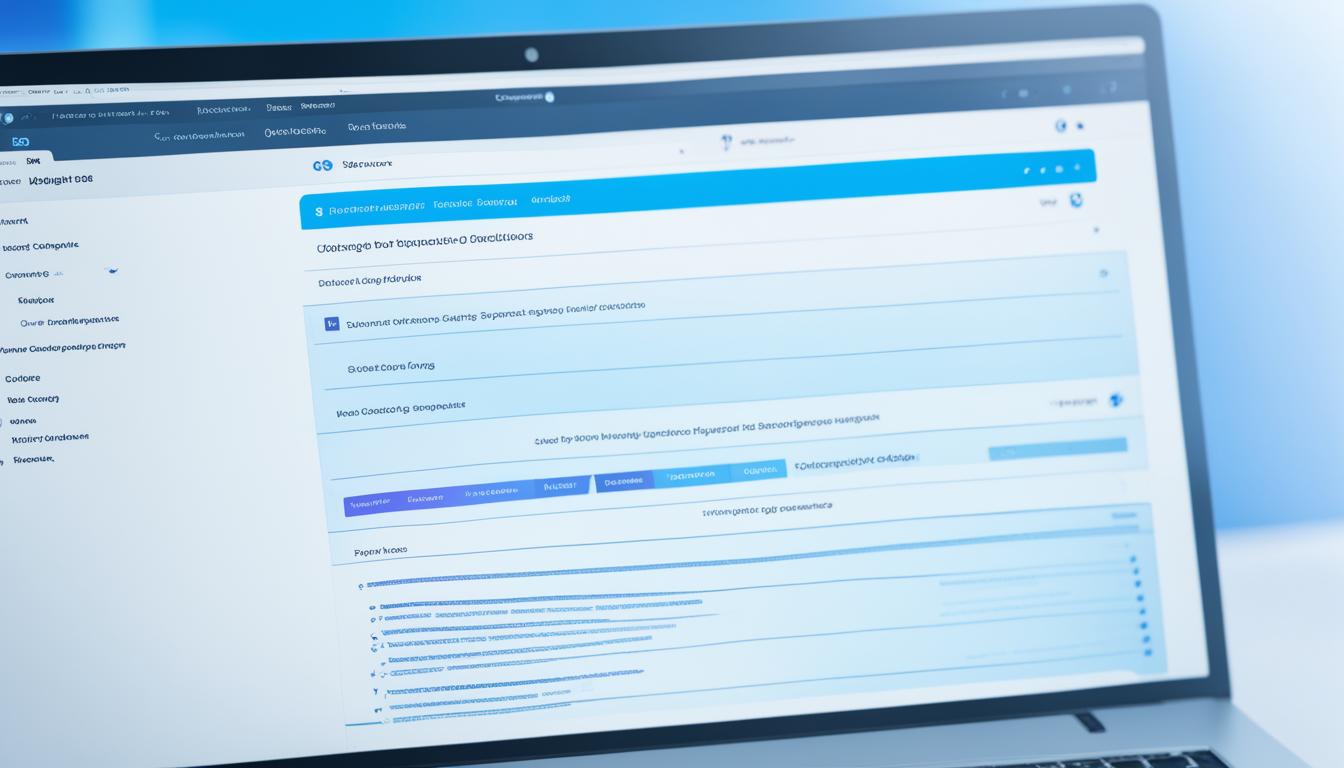How To Code An Ecommerce Website From Scratch?
Did you know that the global ecommerce market is expected to reach a value of $6.3 trillion by 2024? With the rapid growth of online shopping, there has never been a better time to start your own ecommerce website. Whether you’re a coding beginner or an experienced web developer, this step-by-step guide will walk you through the process of coding your own professional and successful online store from scratch.
Key Takeaways:
- Building an ecommerce website can be a daunting task, but with the right guidance, anyone can do it.
- Choosing the right ecommerce platform is crucial for the success of your online store.
- Customizing your website’s theme and design is essential to create a unique and user-friendly experience.
- Crafting compelling product pages will drive sales and customer engagement.
- Setting up secure payment processing and efficient shipping options is vital for a seamless customer experience.
Pick the Right eCommerce Platform
When you’re building an eCommerce website from scratch, the first important decision you need to make is choosing the right platform. With so many options available, it can be overwhelming to find the perfect fit for your business. But fear not, I’m here to help guide you through the process.
One of the main considerations is whether to opt for a hosted eCommerce platform or self-hosting. Self-hosting offers more control over your website but requires technical expertise and can be time-consuming. On the other hand, a hosted eCommerce platform like Wix provides an easy-to-use website builder and a range of tools to manage various aspects of your business.
When selecting a platform, there are a few key factors to keep in mind. First and foremost, consider mobile friendliness. With the majority of online traffic coming from mobile devices, it’s crucial that your platform offers a responsive design that looks great on any screen size.
Security is another critical aspect to consider. You want to ensure that your customers’ personal and payment information is protected. Look for platforms that offer SSL encryption and other security measures to keep your website and data safe.
Reliability is also essential. You want a platform that guarantees uptime and ensures your website is accessible to customers at all times. Downtime can result in lost sales and damage your reputation, so choose a platform that is known for its reliability.
Back-office tools are crucial for managing your eCommerce business efficiently. Look for features like inventory management, order tracking, and customer support tools that will streamline your operations and save you time.
Finally, multichannel capabilities are worth considering. If you plan to sell on multiple platforms, such as social media channels or marketplaces, choose a platform that integrates with these channels seamlessly. This will help you reach a wider audience and boost your sales.
By carefully evaluating these factors and considering your specific business needs, you can pick the right eCommerce platform that sets you up for success in website development and enables you to create a mobile-friendly, secure, reliable, and efficient online store.
Select a Theme and Start Customizing
Now that you’ve chosen the perfect ecommerce platform for your online store, it’s time to select a theme that will define the look and feel of your website. The theme you choose reflects your brand image and plays a crucial role in creating a positive user experience.
When selecting a theme, consider the following factors:
- Website Design: Choose a design that complements your products and appeals to your target audience. Ensure that the layout is clean, visually appealing, and easy to navigate.
- Brand Image: Your theme should align with your brand identity. Incorporate your brand colors, logo, and other visual elements to create a cohesive and recognizable brand image.
- User Experience: Prioritize the user experience by selecting a theme that is intuitive and user-friendly. Optimize for easy navigation, quick load times, and clear calls to action.
- Mobile Responsiveness: With more users browsing on mobile devices, it’s crucial to choose a theme that is mobile responsive. Ensure that your website looks and functions seamlessly on different screen sizes.
- Fonts and Colors: Select fonts and colors that reflect your brand personality and are easy to read. Consistency in font styles and color schemes across your website creates a professional and visually appealing experience.
- Homepage: Customize your homepage to showcase your best-selling products, promotions, or any other important content. Make sure it captures visitors’ attention and encourages them to explore further.
- Navigation: Develop a clear and intuitive navigation menu that allows users to easily find what they’re looking for. Organize your categories and subcategories in a logical manner to enhance user experience.
- Mobile Experience: Pay attention to the mobile experience by optimizing your theme for touch navigation, minimizing long scrolling, and ensuring that all elements are easily accessible on mobile devices.
Customize your chosen theme to make it unique to your brand. Add your own content, images, and branding elements to create a website that stands out from the competition.

Example: Comparison of Top eCommerce Themes
| Theme | Website Design | User Experience | Mobile Responsiveness | Fonts and Colors | Customization Options |
|---|---|---|---|---|---|
| Theme A | Clean and modern design | Intuitive and user-friendly | Fully responsive | Versatile font options and customizable color schemes | Extensive customization options available |
| Theme B | Sleek and minimalist design | Seamless navigation and user flow | Mobile-friendly layout | Elegant typography and carefully chosen color palette | Limited customization options |
| Theme C | Bold and vibrant design | Engaging and interactive features | Optimized for all devices | Wide range of font choices and customizable color combinations | Flexibility to customize various elements |
Create Your Product Pages
Product pages are a crucial component of your ecommerce website. It’s important to carefully create and optimize them to drive sales and upsells. Here are some key elements to consider when designing your product pages:
- Product Names: Choose product names that are easy to recognize and appealing to your target audience. Keep them concise and descriptive.
- Product Images: Use high-quality images that showcase your products from different angles. This allows customers to get a clear and detailed view of what they are purchasing. For example:

- Product Descriptions: Write detailed and informative product descriptions that address common customer questions and concerns. Highlight the features, benefits, and unique selling points of your products.
- Shipping and Return Information: Clearly display shipping options, delivery times, and return policies to set clear expectations for your customers. Transparency builds trust and customer satisfaction.
- Product Reviews: Include customer reviews and ratings on your product pages. Positive reviews act as social proof and can influence purchasing decisions. Encourage customers to leave reviews after making a purchase.
- Cross-Selling and Upselling Opportunities: Take advantage of cross-selling and upselling opportunities to increase your average order value. Recommend related products or offer bundle deals to encourage customers to buy more.
By focusing on these key aspects of your product pages, you can create an engaging and persuasive shopping experience that boosts conversion rates and encourages repeat purchases.
Set Up Payments and Shipping
When building your ecommerce website, it is crucial to set up a seamless payments and shipping system. This ensures a smooth transaction process and enhances the overall shopping experience for your customers.
First, offer multiple payment options to cater to the diverse preferences of your customers. This may include credit card payments, PayPal, or other digital wallets. By providing various payment options, you increase the chances of converting visitors into buyers.
Next, choose a secure and easy-to-integrate payment gateway. Selecting a reliable payment gateway provider such as Stripe or PayPal ensures the safety of your customers’ financial information and facilitates smooth transactions.
Turning to shipping, establish clear shipping policies. Decide whether you want to offer free shipping or charge a flat rate based on weight or distance. Additionally, select the carriers or third-party logistics providers that align with your business needs. Popular carriers like Canada Post or UPS provide reliable and efficient delivery services.
To streamline your shipping processes, consider integrating shipping software platforms like ShipStation or Shippo. These platforms automate shipping tasks, generate shipping labels, and provide real-time tracking. By utilizing such software, you can simplify your operations and deliver a seamless experience to your customers.
FAQ
Is it possible to code an ecommerce website from scratch without any technical expertise?
What are the benefits of using a hosted ecommerce platform?
How should I choose the right theme for my ecommerce website?
What should I include in my product pages to encourage sales?
How can I set up payment processing and shipping options for my ecommerce website?
- Shop for Server & Workstation Systems & more - February 25, 2025
- IP Geolocation API and IP Location Lookup Tools - February 24, 2025
- What is GoDaddy? Everything You Need to Know in 2024 - February 23, 2025





















Post Comment
You must be logged in to post a comment.